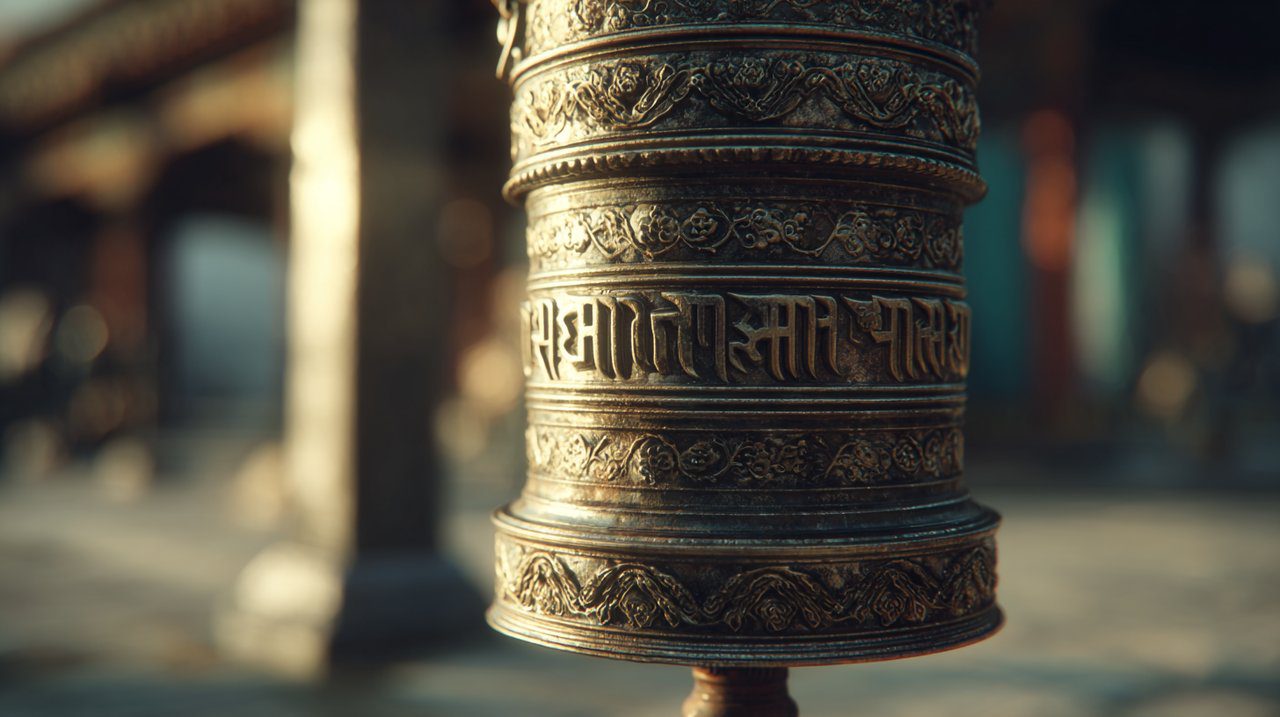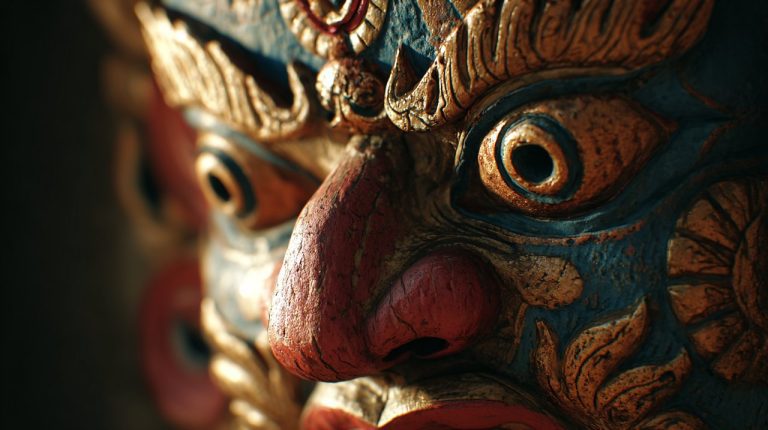What is a Prayer Wheel: Unveiling Its Spiritual Essence and Dynamic Practice
Imagine the rhythmic hum of countless prayers carried on the wind, a silent symphony of devotion emanating from spinning cylinders. For centuries, these remarkable devices have stood as a cornerstone of spiritual practice, particularly within the rich tapestry of Tibetan Buddhism. Far more than mere artifacts, they serve as profound conduits for intention, focused meditation, and the boundless dissemination of compassion.
This exploration delves into the very essence of the prayer wheel, revealing its intricate components, its profound purpose, and its enduring relevance, bridging ancient traditions with the demands of modern life. It is a journey into an object that, at first glance, seems simple, yet holds layers of complex spiritual engineering.

The Sacred Spin: Unveiling the Prayer Wheel’s Essence
At its core, a prayer wheel, or Mani Khorlo in Tibetan, is a cylindrical device meticulously engineered to contain scrolls of sacred texts and mantras. The seemingly simple act of spinning it clockwise is believed to generate the same spiritual merit as the oral recitation of the thousands, or even millions, of mantras encapsulated within. This practice thus transforms a deeply personal spiritual intention into a tangible, dynamic, and far-reaching motion.
A History Forged in Faith
The origins of the prayer wheel can be traced back to ancient India, where early Buddhist practitioners ingeniously sought to multiply the recitation of mantras. As the tenets of Buddhism journeyed across the Himalayas and took root in Tibet, this innovative device was not merely adopted but evolved, becoming an iconic and inseparable symbol of Tibetan spirituality.
Early iterations were often stationary, harnessing the power of natural forces like wind or flowing water. This design choice underscored a deep respect for the elements, allowing nature itself to contribute to spiritual practice. Over time, the design diversified, leading to the widespread adoption of handheld versions, which afforded individual practitioners the profound ability to carry their devotion with them, integrating it seamlessly into their daily lives.
Anatomy of Intention: The Components of a Prayer Wheel
A prayer wheel is, in essence, a beautifully engineered vessel designed to channel and amplify spiritual energy. Each component, far from being arbitrary, plays a vital role in this intricate mechanism, embodying a specific aspect of its sacred function. Understanding these parts allows for a deeper appreciation of the whole:
- The Cylinder: This outer casing, often a work of art crafted from metal, wood, or stone, is typically adorned with intricate carvings of auspicious symbols and the foundational mantra, Om Mani Padme Hum. It is the visible manifestation of the contained spiritual power.
- The Scrolls: Within the cylinder lie meticulously printed or handwritten scrolls, containing countless repetitions of mantras. These are tightly wound around a central spindle, their internal volume symbolizing the vastness and cumulative power of the prayers being activated with each turn.
- The Spindle: This central axis is crucial, allowing the cylinder to spin freely and smoothly. For handheld wheels, a small weight or chain often extends from the cylinder, providing the necessary momentum for a continuous, effortless rotation.
- The “Life Tree”: A central wooden or metal rod, frequently intricately carved, around which the mantra scrolls are wrapped. This element holds profound symbolic weight, often seen as representing the axis mundi—a cosmic axis connecting heaven and earth, thereby grounding and channeling the spiritual energy of the wheel.
The prayer wheel functions as a physical representation of spiritual effort, allowing a single rotation to embody countless repetitions of sacred words, extending blessings far beyond the immediate vicinity. It is a testament to the Buddhist principle of multiplying positive intent through focused action.
Beyond Ritual: The Art of Dynamic Meditation
To view the prayer wheel merely as a ritualistic tool would be to miss its profound depth. It stands as an exceptional instrument for dynamic meditation, actively engaging both body and mind. Its deliberate use encourages a unique blend of physical action and mental focus, offering a tangible pathway to cultivate inner peace and profound spiritual awareness.
Cultivating Presence Through Rotation
The simple, repetitive act of spinning the prayer wheel, particularly a handheld version, can induce a deeply meditative state. As the wheel turns, the practitioner’s focus naturally converges on the motion itself, the subtle whirring sound it produces, and the underlying intention behind the prayers. This gentle, continuous movement serves as a powerful mechanism to quiet the incessant chatter of the mind, anchoring attention firmly in the present moment.
Much like a breath anchor in seated meditation, the prayer wheel draws awareness away from external distractions, guiding the mind toward a state of calm presence. It’s a tactile form of mindfulness, where the physical engagement becomes a gateway to mental clarity and inner stillness, a rare commodity in our fast-paced world.
The Whispering Mantras: Sound, Vibration, and Mind
Central to the prayer wheel’s remarkable power are the mantras meticulously encased within. The most ubiquitous of these is Om Mani Padme Hum, the six-syllable mantra of Avalokiteshvara, the Buddha of Compassion. While the mantras are not audibly recited by the spinner, each revolution is profoundly believed to activate their vibrational energy, silently broadcasting their blessings into the surrounding environment.
This silent, energetic projection highlights a truly unique facet of the practice. It represents a sophisticated form of non-verbal prayer, where the physical act of turning the wheel transcends mere motion, becoming a powerful articulation of spiritual intent. In doing so, it resonates with the cosmic sound of compassion and wisdom, a subtle yet potent force in the world.
Echoes of Enlightenment: The Profound Benefits Unveiled
The consistent practice of engaging with a prayer wheel bestows a spectrum of benefits, extending far beyond traditional spiritual merit to foster a deeper sense of inner tranquility and resilience amidst the complexities of modern life. It is a practice that yields both tangible and intangible rewards.
Merit, Purification, and Compassion in Action
Within Buddhist philosophy, the primary spiritual objective of spinning a prayer wheel is the accumulation of merit, often understood as positive karma, and the simultaneous purification of negative karma. Each rotation is believed to meticulously cleanse negativities, dissolve obstacles, and atone for past misdeeds, while concurrently generating a powerful surge of positive energy. This merit, crucially, is not hoarded for the practitioner alone; it is dedicated to the profound benefit of all sentient beings, embodying the core Buddhist principle of universal compassion.
In this light, the spinning wheel transforms into a potent symbolic gesture, radiating kindness and wisdom outward. It is an act of boundless generosity, touching all corners of existence with its silent, benevolent influence.
A Modern Path to Inner Peace
Even for those who do not adhere to a specific religious tradition, the prayer wheel offers compelling, tangible benefits. The repetitive, focused motion inherent in its use serves as an exceptionally powerful tool for stress reduction and cultivating mental clarity. In a world increasingly characterized by a relentless deluge of digital input and fragmented attention spans, the deceptively simple, physical act of spinning a prayer wheel provides a much-needed anchor.
Consider the experience of a graphic designer navigating the bustling rhythm of a metropolitan city. Her small, handheld prayer wheel became a pivotal daily ritual. “Just five minutes of quiet spinning before starting work clears my mind like nothing else,” she recounted. “It’s my miniature sanctuary in a chaotic day.” This personal, tactile connection to a spiritual object can profoundly ground an individual, fostering a profound sense of peace and mindful presence amidst the ceaseless demands of modern life.
Form and Function: Navigating Prayer Wheel Designs
The prayer wheel manifests in a remarkable variety of forms, each meticulously designed for specific contexts and scales of practice. Understanding these diverse variations provides invaluable insight into their myriad applications and the ingenuity behind their creation.
From Handheld Companions to Temple Giants
The spectrum of prayer wheel designs is wide, ranging from intimate personal tools to monumental communal structures:
- Handheld Prayer Wheels (Mani Khorlo): These are the most common type, intentionally small, portable, and ideally suited for individual daily practice. They frequently incorporate a weighted cord or chain, ingeniously designed to facilitate smooth, continuous spinning with minimal effort.
- Tabletop Prayer Wheels: Larger than their handheld counterparts, these are typically found in homes or dedicated meditation spaces. They can be spun manually, or, in some modern interpretations, may even incorporate a small electric motor for perpetual rotation.
- Water Prayer Wheels: These wheels are powered by the natural flow of water, spinning continuously as a river or stream passes through them. They are often strategically placed near rivers or streams, believed to bless the water and, by extension, all beings touched by it.
- Wind Prayer Wheels: Activated by the wind, these wheels are commonly situated on rooftops or in expansive, open areas. Their constant rotation sends blessings carried on the breeze, permeating the surrounding environment.
- Temple Prayer Wheels: These are massive, often towering structures, frequently encircling monasteries or stupas. Pilgrims undertake circumambulations, spinning each wheel as they pass, thereby accumulating vast merit through a collective act of devotion.
Choosing Your Sacred Tool: Personalizing Practice
When one considers acquiring a prayer wheel, the most paramount aspect is not its aesthetic appeal but its underlying intention. A prayer wheel is, first and foremost, a potent tool for spiritual practice, rather than merely a decorative item. For personal use, a handheld prayer wheel is often considered ideal, offering portability and ease of integration into daily routines.
The selection process should be guided by comfort and functionality: choose one that feels balanced in your hand and spins smoothly. Traditional and durable materials such as copper, brass, or wood are often preferred for their resonance and longevity. While elaborate designs can be aesthetically pleasing, the true essence of the prayer wheel resides in the power of the mantras contained within and the mindful, intentional act of spinning. Ultimately, choosing a prayer wheel is a deeply personal journey, akin to selecting a companion that resonates with one’s spiritual aspirations and steadfastly supports a unique and evolving practice.
Ultimately, what is a prayer wheel? It is a dynamic embodiment of prayer, a tangible manifestation of compassion, and a direct link to a profound spiritual heritage. Yet, its significance extends beyond its ancient roots. It is a testament to the human spirit’s enduring quest for inner peace and connection.
Whether one seeks to deepen a spiritual practice, discover a unique tool for mindfulness in a chaotic world, or simply understand a rich cultural artifact, the prayer wheel extends a quiet yet powerful invitation. Its gentle, continuous spin continues to carry blessings, whispering ancient wisdom into the modern world, offering not just a path to inner tranquility but a profound testament to boundless good will—a timeless symphony of devotion that echoes through the ages, just as it began.
💡 Frequently Asked Questions
A prayer wheel, or Mani Khorlo, is a cylindrical device used in Tibetan Buddhism that contains scrolls of sacred texts and mantras. Its primary function is to generate spiritual merit and disseminate compassion by spinning it clockwise, which is believed to be equivalent to orally reciting the mantras within.
A prayer wheel consists of an outer cylinder, meticulously printed or handwritten mantra scrolls wound around a central spindle, and often a 'Life Tree' which is a central rod symbolizing a cosmic axis. Handheld versions may also include a small weight or chain for continuous rotation.
Using a prayer wheel is believed to accumulate spiritual merit, purify negative karma, and serve as a tool for dynamic meditation. It helps cultivate presence, reduce stress, and foster inner peace by focusing the mind through repetitive motion and silent activation of mantras.
Prayer wheels come in various forms, including small, portable handheld versions for individual practice, tabletop wheels, water-powered wheels, wind-activated wheels, and massive temple wheels often found encircling monasteries.







